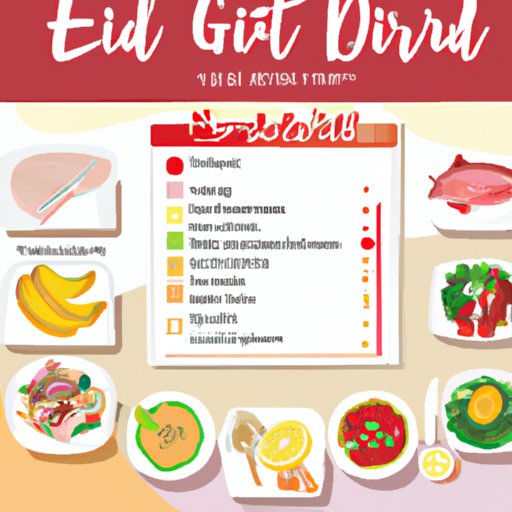Introduction
Gastroesophageal reflux disease (GERD) is a chronic digestive disorder that affects the lower esophageal sphincter (LES). This condition causes frequent heartburn, acid reflux, and other uncomfortable symptoms. While medications can help alleviate symptoms, making dietary and lifestyle modifications is also an important part of managing GERD. One such modification is following a GERD diet, which is designed to reduce or prevent symptoms while promoting overall health and wellness.
Overview of GERD Diet
A GERD diet is a dietary approach specifically tailored to people with GERD. It involves eating foods that are less likely to cause GERD symptoms and avoiding those that are more likely to trigger them. The goal is to reduce the frequency and severity of GERD symptoms while still consuming a nutritious and balanced diet. Some of the most common benefits of following a GERD diet include reduced acid reflux, fewer episodes of GERD-related chest pain, improved digestion, and better overall health.

Comprehensive Guide to the GERD Diet
If you’re looking to make dietary changes to manage your GERD symptoms, here is a comprehensive guide to get you started.
Foods to Include
The first step in following a GERD diet is to identify which foods should be included in your diet. Generally speaking, it’s best to focus on eating whole, unprocessed foods that are high in fiber and low in fat. Some of the best foods to include in a GERD diet include:
- Fruits and vegetables
- Whole grains
- Lean proteins, such as fish, poultry, and beans
- Low-fat dairy products
- Healthy fats, such as olive oil and avocados
It’s also important to drink plenty of water throughout the day and limit your intake of caffeine and alcohol. According to one study, “patients who eliminated caffeinated beverages had significantly fewer symptoms than before treatment.”
Foods to Avoid
In addition to including certain foods in your diet, it’s also important to avoid foods that can trigger GERD symptoms. These include fried and fatty foods, spicy foods, acidic foods (such as citrus fruits and tomatoes), garlic and onions, chocolate, carbonated beverages, and mint. It’s also best to avoid large meals, as this can put extra pressure on the LES and worsen GERD symptoms.
Different Types of GERD Diets
There are several different types of GERD diets, each of which has its own unique set of guidelines. Here are some of the most popular types of GERD diets.
Low-Acid Diet
A low-acid diet is designed to reduce the amount of acid in the stomach. This is done by limiting foods that are high in acid, such as citrus fruits, tomatoes, vinegar, and processed meats. Other recommended foods include lean proteins, non-citrus fruits, vegetables, legumes, and whole grains.
Low-Fat Diet
A low-fat diet is designed to reduce the amount of fat in the diet. This is done by limiting foods that are high in fat, such as red meat, cheese, butter, and full-fat dairy products. Other recommended foods include lean proteins, non-starchy vegetables, and whole grains.
Elimination Diet
An elimination diet is a type of GERD diet in which certain foods are eliminated from the diet for a period of time. Commonly eliminated foods include dairy, wheat, soy, eggs, corn, and yeast. After a few weeks, these foods are slowly reintroduced back into the diet to determine which ones are triggering GERD symptoms.
GERD Diet Recipes
Following a GERD diet doesn’t have to be boring or restrictive. There are plenty of delicious meals that can help you manage your GERD symptoms while still enjoying the foods you love. Here are some ideas to get you started:
- Grilled salmon with roasted vegetables
- Vegetable stir-fry with brown rice
- Chicken and vegetable soup
- Turkey burger with sweet potato fries
- Tuna salad wrap with lettuce and tomatoes
You can also find many more delicious and GERD-friendly recipes online.

Meal Planning for the GERD Diet
Once you’ve identified which foods to include in your GERD diet, it’s important to plan ahead so you can stick to it. Here are some tips to help you get started:
- Make a list of GERD-friendly meals that you enjoy.
- Schedule time each week to plan meals and shop for groceries.
- Prepare meals in advance so you have easy, healthy options during the week.
- Keep healthy snacks on hand to reduce cravings for unhealthy foods.
If you’re eating out, it’s best to choose restaurants that serve healthy, GERD-friendly meals. Look for restaurants that offer grilled or steamed options, as well as salads without added dressings. You can also ask the server for advice on GERD-friendly menu items.
Conclusion
Following a GERD diet is an important part of managing GERD symptoms. By including certain foods in your diet and avoiding others, you can reduce the frequency and severity of GERD symptoms. It’s also important to plan ahead and eat healthy meals whenever possible. With a little effort and dedication, you can successfully manage your GERD symptoms and improve your overall health.
(Note: Is this article not meeting your expectations? Do you have knowledge or insights to share? Unlock new opportunities and expand your reach by joining our authors team. Click Registration to join us and share your expertise with our readers.)
